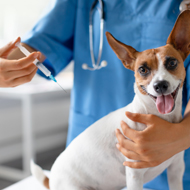Rescue dog saves puppy’s life with blood donation
Taurus was rescued by the RSPCA in November 2022.
A five-year-old dog, rescued by the Royal Society for the Prevention of Cruelty to Animals (RSPCA), has saved the life of a 16-week-old puppy which needed a blood transfusion.
Rescue dog Taurus was at Birmingham Animal Centre at Newbrook Farm when the puppy, Percy, was brought into a nearby animal hospital.
When Percy arrived at Birmingham Animal Hospital he was small, unwell, and desperately needed a blood transfusion to help him to rebuild his strength.
Dog blood donors have to be vaccinated, fit, healthy, and weigh more than 25kg. They must be aged between one and eight-years-old, and have a good temperament so that they don’t find the experience stressful.
The kennels team at the nearby animal centre suggested that Taurus would be an ideal candidate.
He donated 175ml of blood and, while Percy’s condition is still uncertain, the team believe the transfusion has given him the best possible chance.
Taurus was rescued by the RSPCA in November 2022, with a large number of other dogs. He stayed in police kennels for sometime, before he was transferred to Birmingham Animal Centre in September 2023.
While helping him find his forever home, the team at Newbrook Farm soon discovered his loving and gentle nature. However, they believe that Taurus’ ‘intimidating’ appearance may be deterring potential owners.
Taurus is a mastiff-cross, and arrived at the RSPCA with cropped ears.
Ear-cropping is an illegal practice, where a dog’s ear is partially or fully removed for cosmetic reasons. This can cause lifelong health, welfare and behavioural difficulties for dogs.
Kelly Legg, kennel supervisor at RSPCA Birmingham, said: “Taurus is such a loving and sweet boy and he’s very relaxed in the hospital environment so we knew he’d be comfortable giving blood.
“This soft side of Taurus is why all of us have fallen in love with him, but, sadly, we believe many people aren’t seeing this side of him and are being put off due to his intimidating appearance caused by his cropped ears.”
She added: “He’s been waiting so long to find a new home and we hope that one day soon someone will see the light that shines so brightly in his heart and become his new family.”
Image © RSPCA



 RUMA CA&E has extended the deadline for its online survey into vaccine availability.
RUMA CA&E has extended the deadline for its online survey into vaccine availability.